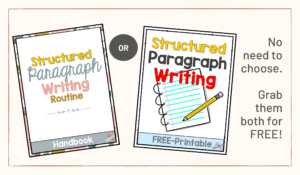We Don’t Eat Our Classmates, written by Ryan T. Higgins, is one of my favorite back to school read-aloud books. With a few meaningful and engaging activities focusing on friendship, your students will be off to a smooth year!
The story is about a very nervous dinosaur named Penelope Rex, who is starting the new school year in a classroom full of children. Quickly students learn that Penelope has difficulty making friends due to her desire to eat the children.
You can pick up your own copy here with my Amazon Affiliate Link. Thanks!
Since We Don’t Eat Our Classmates is such a big hit with the students, I created a week’s worth of Language Arts lessons to accompany the book. Here are just a few reasons why I love We Don’t Eat Our Classmates and a few activities you might want to share with your own class.
A great read-aloud such as We Don’t Eat Our Classmates will always include rich vocabulary. I have found seven vocabulary words from the story to enrich my student’s vocabulary.
When teaching vocabulary, I have found that a strong vocabulary routine is most beneficial. My routine consist of four steps:
I choose to teach half the words in one sitting and the other before the text’s second reading. The last step is to put the vocabulary words into my Vocabulary Activities as a literacy center.
I also fell in love with this book because of the variety of sentence types used throughout the book. We Don’t Eat Our Classmates makes reading the story fun and engaging with plenty of opportunities for the student to read with expression each statement, questions, explanation, and command.
Once the four sentence types are modeled and practiced, students then complete activities. In this activity, students match the punctuation to the sentence and then either find more sentences of each sentence type in the book or create their own.
The biggest bang for your buck when reading We Don’t Eat Our Classmates is a character analysis lesson. The story progresses, where students quickly decide that Penelope has had a change of heart. You can check out my simple yet highly effective activity in the image.
While you’re at it, you won’t want to ignore the theme of the story. By the end of the story, students quickly recognize the importance of being a good friend.
Lastly, every great read-aloud requires a great writing opportunity. I chose to focus on not one but three writing prompts to apply their paragraph writing skills.

While we are on the subject of writing, make sure your students have a solid grasp of paragraph writing. Check out my FREE Structured Paragraph Handbook, which will guide you and your students through the steps needed to create the perfect paragraph.
If you would like to see all the activities for We Don’t Eat Our Classmates in more detail, I have a preview listed in my Teachers Pay Teachers store.
A great read-aloud, plus fun and engaging activities, makes for a great week back to school!